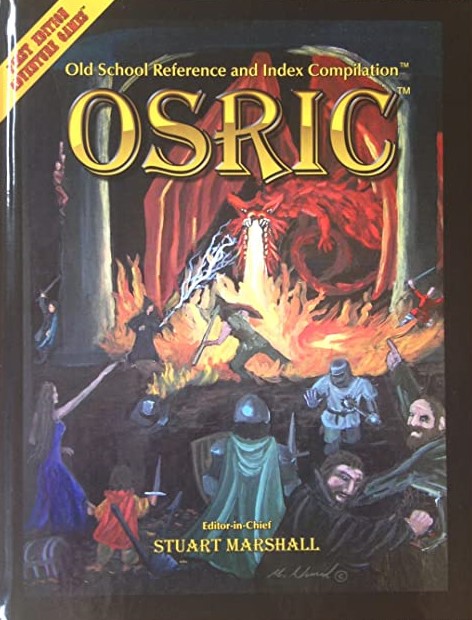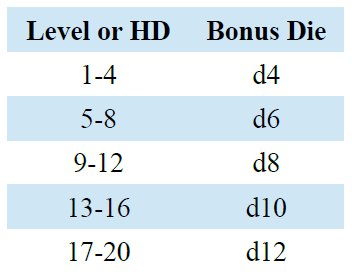OSRIC: The Bonus Die, Part 1

Last time I wrote about OSRIC, I pondered about how I might incorporate something along the lines of assets and complications in the style of Margaret Weis Productions’ Marvel Heroic Roleplaying Game (MHRG). Today, I continue those thoughts.
Let’s start by designating Attack, Damage, Defense, and Saving Throws as the areas for which assets and complications may apply. In each area, an asset provides an additional die that generates a bonus, and a complication provides an additional die that generates a penalty. The size of the bonus die (a generic term that applies to both assets and complications) depends on the character’s level or the creature’s Hit Dice (as shown on the nearby table).
Next, some ground rules about bonus dice:
- The decision to use the bonus die must be made before any other dice are rolled.
- A bonus die’s result applied to Attack or Defense is halved (round up). A modifier to a to-hit roll is a lot like a modifier to damage as well since hitting more or less often means inflicting more or less damage.
- The bonus die is good for a single round.
- It is possible that more one bonus die may apply depending on the situation.
- The duration of a bonus die varies based on its nature, the situation, and the DM’s judgment.

A creature’s ability to create an asset or complication is a function of its level/HD opposed by the level/HD of the target. (For now, I’m ignoring targets that don’t have a level/HD, such as a trap.) The creature attempting to create the asset or complication is the actor. The target is the target. The actor rolls 1d20 + his level/HD – the target’s level/HD. If the modified d20 result is 11 or better, the actor succeeds and creates an asset or complication of the appropriate die size.
So, that takes care of the mechanical aspects. We must now consider the narrative aspects because no actor can create a bonus die without describing the nature of the proposed asset or complication. This requires a concise, complete description of what the actor is attempting and how success justifies the effects of the bonus die. The DM has final say over whether the proposed course of action is possible.
For Example
Christopher is playing a halfling thief named Wiggles, who is engaged in combat with a well-armed and armored mercenary ogre. Wiggles and his fellow adventurers face a grim and deadly foe, one who excels at inflicting and absorbing damage. Recognizing that the group’s best chance for success rides on the shoulders of Bric and Brac, the group’s twin fighters played by Terry and Eric, Wiggles gets clever.
“You mentioned there’s a tapestry on the wall near the table?” Christopher says, and the DM nods. “Excellent! Wiggles jumps onto the table and yanks the tapestry down so that it covers the ogre.”
The DM approves this course of action, and Christopher rolls 1d20, adding Wiggles’s level and subtracting the ogre’s HD. The modified d20 result is a 13, a success! Wiggles’s bonus die is a d4.
Terry’s fighter, Shay Magnifique, acts next. Terry decides to use the bonus die as a modifier for his to-hit roll. He rolls 1d20 and 1d4, remembering to halve (rounding up) the latter’s result. Thanks to the bonus die, Shay’s attack succeeds! Ray Magnifique attacks next, using the bonus die as a damage modifier. Eric’s to-hit roll succeeds, and he gets an extra d4 added to his damage!
The ogre tears away tapestry, staggering from the severity of his wounds as he raises his huge club for the attack….
Next up? Further exploration of this idea, including how it might apply to noncombat situations.

Leave a Reply